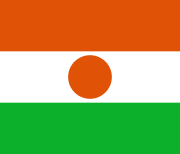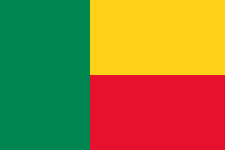Zarma people
Zarma|

Young girls wearing traditional Zabarma dress |
| Total population |
|---|
|
3,459,000 |
| Regions with significant populations |
|---|
 Niger Niger |
3,300,000 |
|---|
 Nigeria Nigeria |
113,000 |
|---|
 Benin Benin |
38,000 |
|---|
 Ghana Ghana |
6,900 |
|---|
 Burkina Faso Burkina Faso |
1,100 |
|---|
| Languages |
|---|
|
Zarma |
| Religion |
|---|
|
Islam |
| Related ethnic groups |
|---|
|
Songhai, other Nilo-Saharan groups, Fula, Hausa, Mande |
The Zarma people (var. Djerma, Zerma, Dyerma, or Zabarma), are a people of westernmost Niger and adjacent areas of Burkina Faso, Benin, Ghana and Nigeria. The Zarma language is one of the Songhai languages, a branch of the Nilo-Saharan language family. Because of the common language and culture, they are sometimes referred to as "Zarma Songhay" (also spelled "Djerma-Songhai"). Zarma actually constitute several dozen smaller ethnic groups, who were either indigenous to the era prior to the Songhai Empire and have assimilated into the Zarma people, or else are people of Zarma origins who have differentiated themselves some time in the precolonial period (through dialect, political structure, or religion).[1] Groups usually referred to as part of the Zarma or Songhay, but who have traceable historical distinctions include the Gabda, Kado, Tinga, and Sorko peoples.
The Zarma live in the arid lands of the Sahel. Many live in the Niger River valley and exploit the river for irrigation. They grow millet, sorghum, rice.
History
The Zarma people are believed to have migrated from what is now the Fula region around Lac Debo, Mali during the Songhai Empire, and settled first in Anzourou and Zarmaganda in the 16th century. In the 18th century, many Zarma resettled south to the Niger River valley, the Fakara plateau and Zigui in what is now Southwest Niger near Niamey. Forming a number of small communities, each led by a Zarmakoy, these polities soon found themselves pressured from the north by the Tuareg and the Fula from the southeast, as well as other ethnic groups in the area. While Zarmakoy Aboubacar founded the Dosso state from his own Taguru clan around 1750, it remained a small collection of villages in the Dallol Bosso valley until the 1820s, when it led much of the resistance to the Sokoto Caliphate. While Dosso fell under the control of the Amir of Gando (a sub division of Sokoto) between 1849 and 1856, they retained their Zarmakoy and the nominal rule of a much larger Zarma territory, and were converted to Islam. Under Zarmakoy Kossom (r. 1856-65), Dosso united all of the eastern Zarma, and left a small state stretching from Tibbo and Beri in the north, to Gafiadey in the south, and to Bankadey and Tombokware in the east.
References
- ↑ Flugelstad (1983) contends that we may never know which groups have split and which groups have cleaved from the Zarma in the period of the 16th to 19th centuries. Regardless, since the beginning of the 20th century, the trend has been decisively towards disparate groups assimilating into Zarma language and culture.
- Notes
- Samuel Decalo. Historical Dictionary of Niger. Scarecrow Press/ Metuchen. NJ - London (1979) ISBN 0-8108-1229-0
- Finn Fuglestad. A History of Niger: 1850-1960. Cambridge University Press (1983) ISBN 0-521-25268-7
- Encyclopædia Britannica Online.
External links